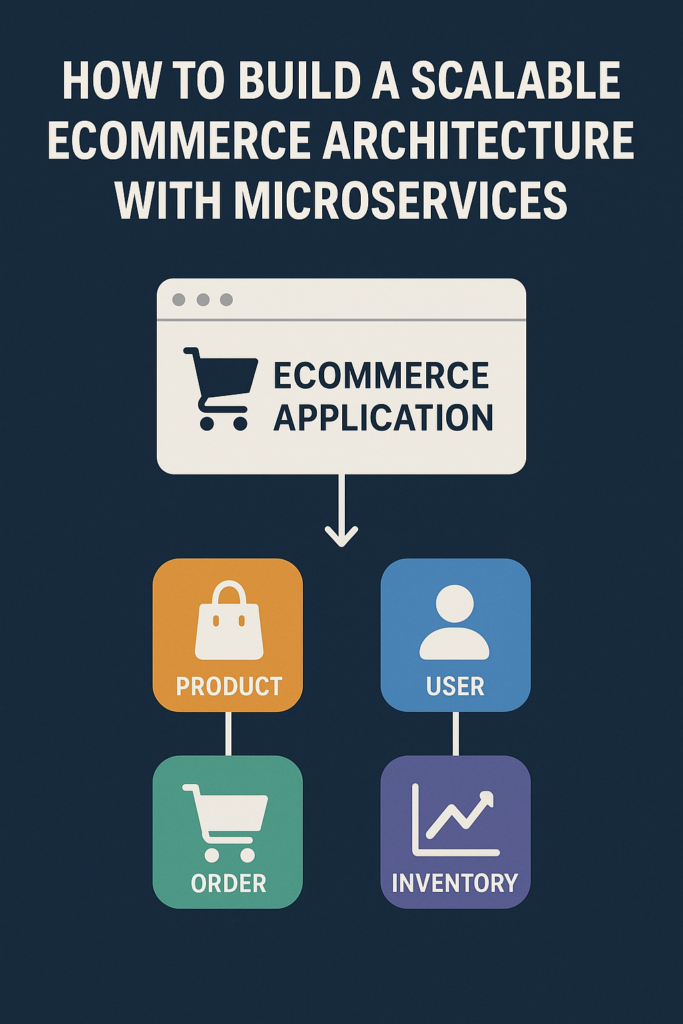In today’s digital marketplace, scalability isn’t just a feature—it’s a necessity. As customer expectations grow and traffic spikes become more unpredictable, eCommerce businesses need to adopt an architecture that is flexible, resilient, and scalable. This is where microservices come into play.
In this blog, we’ll explore how to build a scalable eCommerce architecture using microservices, the key components involved, and best practices to ensure long-term success.
🔍 What Are Microservices?
Microservices is an architectural style where applications are broken down into smaller, independent services that communicate with each other over APIs. Each service is focused on a single business capability, such as user management, inventory, payment, or order processing.
This approach contrasts with monolithic systems, where all functionality is tightly coupled and deployed as a single unit—making it hard to scale or modify individual components.
🧱 Why Use Microservices for eCommerce?
Here are a few reasons why microservices are ideal for eCommerce platforms:
- Scalability: Scale individual services (like checkout or product search) based on load.
- Flexibility: Develop and deploy features independently.
- Resilience: Failure in one service won’t crash the entire system.
- Faster Time to Market: Parallel development speeds up product launches.
- Technology Diversity: Use the right language or tool for each service (e.g., .NET for payments, Node.js for product catalogs).
🏗️ Core Components of a Microservices-Based eCommerce Architecture
Here’s what a basic microservices setup for eCommerce looks like:
- API Gateway
- Handles routing, security, rate limiting, and aggregating data from multiple services.
- Example: Kong, Amazon API Gateway, Azure API Management
- Authentication & Authorization Service
- Centralized service for managing user identity (OAuth2, JWT, etc.).
- Product Catalog Service
- Manages product data, categories, images, pricing, and metadata.
- Inventory Management Service
- Real-time stock updates, reservations, and warehouse integrations.
- Shopping Cart Service
- Manages cart items, promotions, and session-based storage.
- Order Management Service
- Handles order creation, status updates, and tracking.
- Payment Service
- Integrates with payment gateways and handles transaction status securely.
- Notification Service
- Sends emails, SMS, push notifications (order confirmation, shipment, etc.).
- Search Service
- Provides full-text or filtered search using tools like Elasticsearch.
- Analytics and Reporting
- Collects and analyzes data for business intelligence and performance.
- Database per Service
- Each microservice should manage its own database to avoid tight coupling.
🔄 How Services Communicate
- Synchronous (REST, gRPC): For real-time interactions like user login or checkout.
- Asynchronous (Message Queues, Event Streams): For processes like order processing or sending emails.
- Tools: RabbitMQ, Apache Kafka, Azure Service Bus
⚙️ Deployment Considerations
- Containerization: Use Docker to package each service for consistent deployment.
- Orchestration: Use Kubernetes or Docker Swarm to manage containers and scale them dynamically.
- CI/CD Pipelines: Automate testing, building, and deployment per service.
✅ Best Practices
- Design Around Business Capabilities
Each microservice should represent a business domain (not a technical function). - Keep Services Loosely Coupled
Avoid tight dependencies. Services should function independently and degrade gracefully. - Use Centralized Logging and Monitoring
Tools like ELK Stack, Prometheus + Grafana, or Datadog help trace issues across services. - Secure APIs and Data Flow
Use HTTPS, API keys, rate limiting, and identity tokens to secure your architecture. - Version Your APIs
This prevents breaking changes as you update services.
🧪 Real-World Example
Let’s say you run a fashion eCommerce platform. During a flash sale, traffic to the product catalog and checkout increases drastically. With a microservices setup:
- The Product Catalog Service can scale independently without touching the order or payment services.
- The Checkout Service can be monitored and scaled based on conversion funnel metrics.
- If the Email Service crashes, the order still completes and emails are retried later asynchronously.

🚀 Final Thoughts
Microservices empower eCommerce platforms to evolve quickly, scale efficiently, and respond to user demands without compromising reliability. While they come with their own complexities—like service orchestration and distributed data management—the long-term benefits in flexibility and performance are well worth the investment.
If you’re considering transitioning from monolith to microservices, start with a single domain (like order or catalog) and iterate. With the right architecture, your eCommerce system can grow with your business—not against it.
Need help architecting your eCommerce platform with microservices?
We specialize in designing and developing scalable, cloud-native solutions for modern eCommerce businesses. Contact us to discuss your project.

🛠️ Challenges to Watch Out For
While microservices offer many advantages, it’s important to be aware of common challenges:
- Service Coordination Complexity
Managing interactions between dozens of services can become complex without clear contracts and orchestration mechanisms. - Distributed System Failures
With more moving parts, there’s a higher chance of partial failures. Implement fallback strategies like circuit breakers (using tools like Resilience4j or Polly). - Data Consistency
Traditional ACID transactions are harder in a distributed system. You’ll often need to embrace eventual consistency and design with sagas or distributed transactions. - Deployment Overhead
Managing hundreds of services can get overwhelming without automation tools like Kubernetes, Helm, or Terraform. - Monitoring and Debugging
Debugging becomes harder when a request flows through multiple services. Distributed tracing (e.g., Jaeger, OpenTelemetry) becomes essential.
🧰 Recommended Tech Stack for eCommerce Microservices
Depending on your needs and scale, here’s a modern stack to consider:
| Layer | Tools/Technologies |
|---|---|
| API Gateway | Kong, AWS API Gateway, NGINX |
| Service Communication | REST, gRPC, GraphQL |
| Event Streaming | Apache Kafka, RabbitMQ, Azure Event Grid |
| Databases | PostgreSQL, MongoDB, Redis (per service) |
| Authentication | OAuth2, OpenID Connect, Keycloak |
| Containerization | Docker |
| Orchestration | Kubernetes, Amazon ECS, Azure Kubernetes Service |
| Monitoring | Prometheus, Grafana, Datadog |
| Logging | ELK Stack (Elasticsearch, Logstash, Kibana) |
| CI/CD | Jenkins, GitHub Actions, GitLab CI/CD |
This tech stack ensures not just scalability but also performance, security, and operational excellence.
🔥 Final Takeaways
Building a scalable eCommerce architecture with microservices is not just about splitting your code into smaller parts. It’s about rethinking how your platform operates, communicates, and evolves.
Done right, it empowers your business to:
- Launch features faster 🚀
- Scale to meet customer demand 📈
- Innovate with less risk 🧠
If you’re starting today, focus on domain-driven design, API-first development, and continuous delivery pipelines. Gradually mature your infrastructure as your traffic and product complexity grow.
📢 Let’s Build the Future of eCommerce Together
At [Your Company Name], we help ambitious businesses design scalable, microservices-driven eCommerce solutions that are future-ready.
Whether you are modernizing a legacy monolith or building a new platform from scratch, our team of experts can help you architect, develop, and deploy faster—with confidence.
👉 Ready to scale? Contact Us to schedule a free consultation.





Leave a Reply